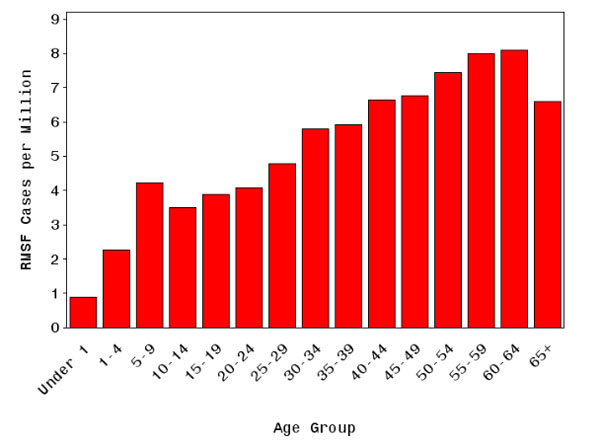Rocky Mountain spotted fever epidemiology and demographics
|
Rocky Mountain spotted fever Microchapters |
|
Differentiating Rocky Mountain spotted fever from other Diseases |
|---|
|
Diagnosis |
|
Treatment |
|
Case Studies |
|
Rocky Mountain spotted fever epidemiology and demographics On the Web |
|
American Roentgen Ray Society Images of Rocky Mountain spotted fever epidemiology and demographics |
|
FDA on Rocky Mountain spotted fever epidemiology and demographics |
|
CDC on Rocky Mountain spotted fever epidemiology and demographics |
|
Rocky Mountain spotted fever epidemiology and demographics in the news |
|
Blogs on Rocky Mountain spotted fever epidemiology and demographics |
|
Directions to Hospitals Treating Rocky Mountain spotted fever |
|
Risk calculators and risk factors for Rocky Mountain spotted fever epidemiology and demographics |
Editor-In-Chief: C. Michael Gibson, M.S., M.D. [1] Associate Editor(s)-in-Chief: Ilan Dock, B.S.
Overview
Since the 1920's the United States Center for Disease Control and Prevention has deemed Rocky Mountain spotted fever (RMSF) as a reportable disease. RMSF cases were most often reported within the Rocky Mountain region, although recent data reveals that the disease is widespread throughout the United States. Areas that currently harbor the majority of RMSF infections are Oklahoma, Tennessee, and Arkansas. The disease has also been reported throughout the Western Hemisphere. [1] Incidence is highest among children the between the ages of 5-9 years and adults between the ages of 40-64 years. Fatality rates are also higher among these groups, with the highest fatality rate in the elderly at 60 years or more. In terms of demographics, Rocky Mountain spotted fever has been reported at higher rates among males, especially of White and Native American descent. [2]
Epidemiology and Demographics
Incidence
- Rocky Mountain spotted fever has been a reportable disease in the United States since the 1920s.
- In the last 50 years, approximately 250-1200 cases of Rocky Mountain spotted fever have been reported annually, although it is likely that many more cases go unreported.
- CDC compiles the number of cases reported by the state health departments.
- To ensure standardization of reporting across the country, CDC advises that a consistent case definition be used by all states. [1]

Seasonal Distribution of Rocky Mountain spotted fever
- Over 90% of patients with Rocky Mountain spotted fever are infected during April through September.
- This period is the season for increased numbers of adult and nymphal Dermacentor ticks.
- A history of tick bite or exposure to tick-infested habitats is reported in approximately 60% of all cases of Rocky Mountain spotted fever.[1]

Geography of Rocky Mountain spotted fever
- RMSF cases have been reported throughout most of the contiguous United States, five states (North Carolina, Oklahoma, Arkansas, Tennessee, and Missouri) account for over 60% of RMSF cases. The primary tick responsible for R. rickettsii in these states is the American dog tick (Dermacentor variabilis Dermacentor andersoni).
- In eastern Arizona, RMSF cases have recently been identified in an area where the disease had not been previously seen. Through 2009, over 90 cases had been reported, and approximately 10% of the people diagnosed with the disease in this part of the state have died. The tick responsible for transmission of R. rickettii in Arizona is the brown dog tick (Rhipicephalus sanguineus), which is found on dogs and around people’s homes.
- Almost all of the cases occurred within communities with a large number of free-roaming dogs.[1]
- Other incidences have recently been reported in portions of California, the Northwest (Washington, and Oregon), and in portions of the Southwest (Arizona, Texas, and New Mexico.)

Age
- Incidence rate is highest among children between the ages of less than 10 years of age, particularly 5-9, and adults between the ages of 40-64. [2]
- Children ages 0-9 and adults ages 60 or higher are at a higher risk of fatality.[1]

Demographics
- The frequency of reported cases of Rocky Mountain spotted fever is highest among males, particularly of Caucasian and American Indian descent.
- Two-thirds of the Rocky Mountain spotted fever cases occur in children.
- Individuals with frequent exposure to dogs and who reside near wooded areas or areas with high grass may also be at increased risk of infection. [2]
Worldwide Infection
- Incidences of Rocky Mountain spotted fever are most prominent in the Western hemisphere.
- Infections have been documented in portions of Argentina, Brazil, Colombia, Costa Rica, Mexico, and Panama.
- Some synonyms for Rocky Mountain spotted fever in other countries include tick typhus, Tobia fever(Colombia), São Paulo fever, fiebre maculosa (Brazil), and fiebre manchada (Mexico).
- Closely related organisms cause other types of spotted fevers in other parts of the world.
References
- ↑ 1.0 1.1 1.2 1.3 1.4 Rocky Mountain Spotted Fever Statistics. Centers for Disease Control and Prevention (2015). http://www.cdc.gov/rmsf/stats/ Accessed on December 30, 2015
- ↑ 2.0 2.1 2.2 Dantas-Torres, Filipe. Lancet Infect Disease 2007;7:724-32. Department of Immunology, Center of Research Aggeu Magalhaes, Oswaldo Cruz Foundation. Recife Pernambuco, Brazil. Volume 7, November 2007. Accessed on January 11, 2016